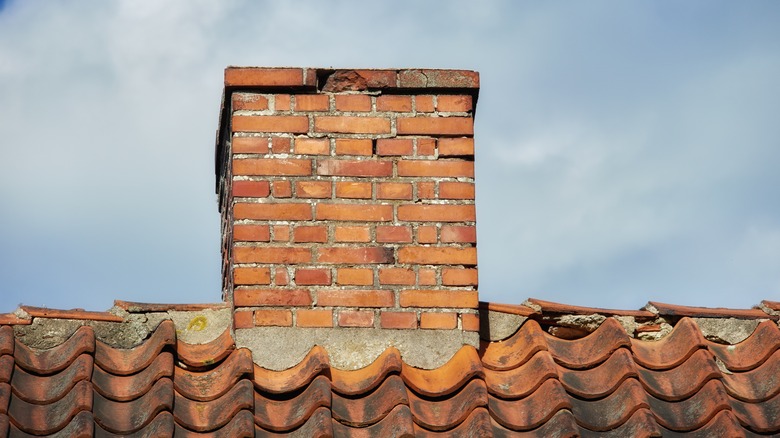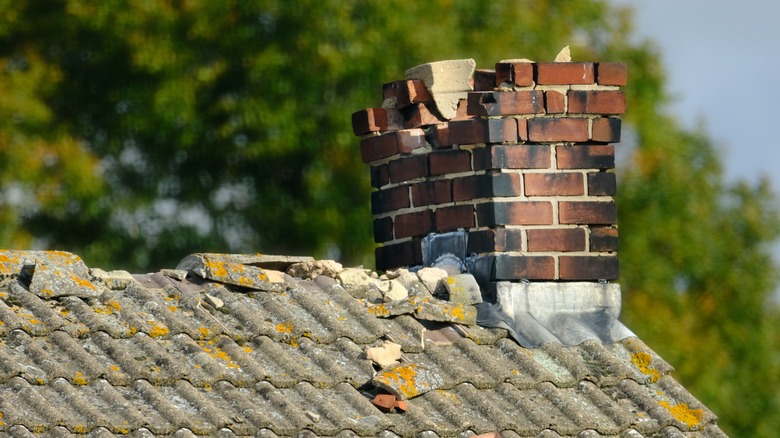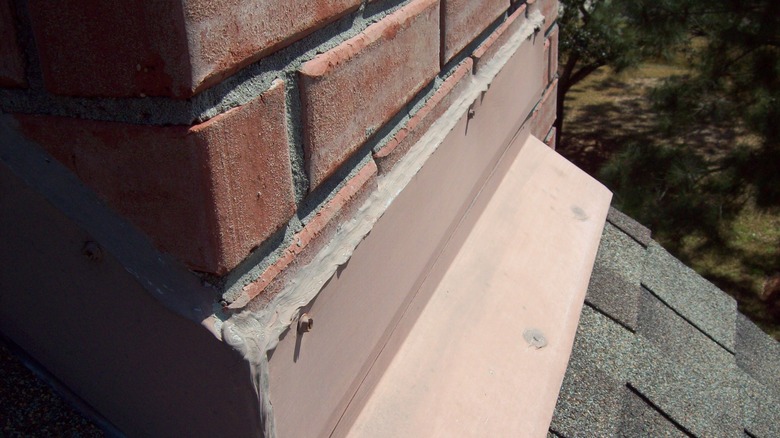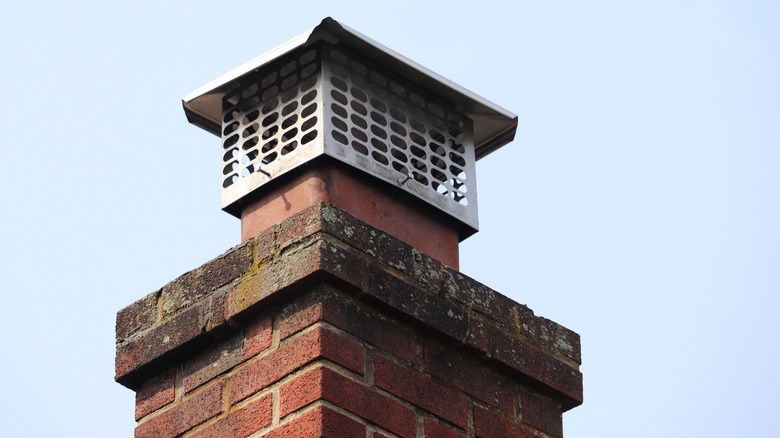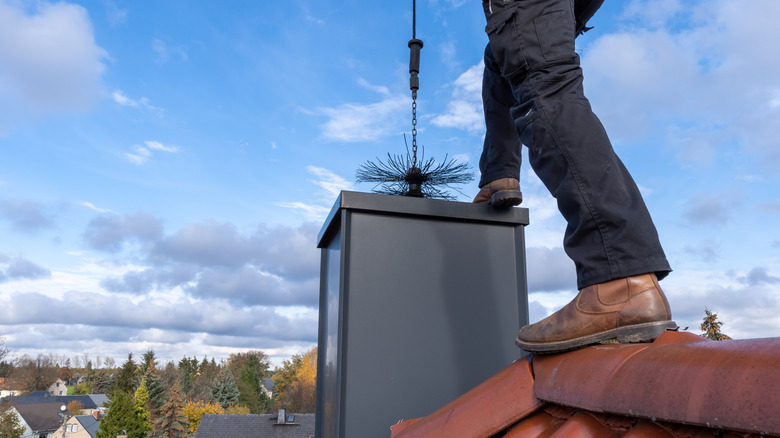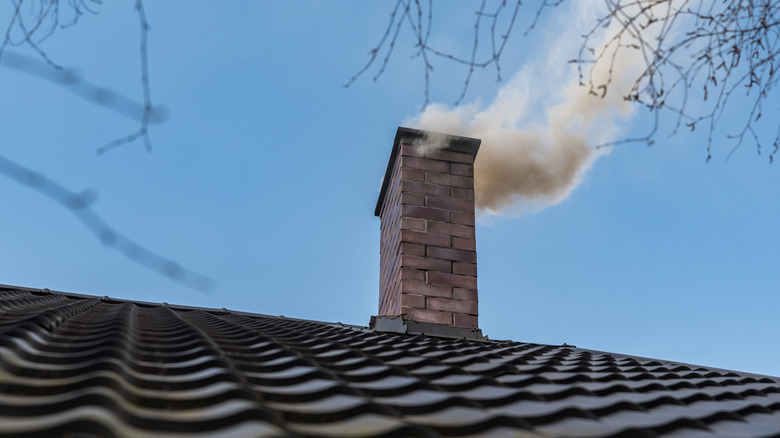How To Prepare Your Chimney For Winter Use
When it starts getting frosty outside, nothing beats the comforting warmth of relaxing by a crackling fire. However, owning a home with a fireplace comes with a fair amount of responsibility, as using it without maintaining the chimney is a recipe for disaster. Chimneys, or flues, are designed to allow smoke and dangerous gasses to move safely out of houses, but they fail to operate properly when obstructed or damaged (per Long Home Products).
As such, you should thoroughly inspect and maintain your chimney and fireplace every year before use during the fall or winter months. There are a variety of ways in which a flue can fail, so preparing it for the winter will require more than a quick glance. For starters, you'll want to inspect the masonry, flashing, and cap, as well as provide a thorough cleaning before using your fireplace. However, unless you're knowledgeable about all the inner workings of chimneys, it's best to hire professionals to conduct an annual inspection to ensure it stays in perfect working order.
Check for masonry damage
Shabby masonry is often a sign there's something seriously wrong with a chimney, such as moisture damage or a compromised flashing. Knowing this, it's a good idea to quickly inspect yours for any signs of masonry damage before starting a fire in the winter (per Doctor Flue). Such damage is often caused by moisture that penetrates through cracks in the stone or mortar and expands in freezing weather. Of course, intense seasonal storms and excessive heat can also be damaging to stone and brick surfaces, especially over a long time period.
Unfortunately, loose bricks or mortar will often necessitate a repair since they can throw your chimney's structural integrity into disarray. This, of course, can be exacerbated by the extreme heat of winter fireplace usage. For this reason, closely inspect its mortar joints every winter and keep an eye out for mortar fragments that may have fallen from your flue (per Environmental Chimney Service).
Inspect your chimney flashing
According to Priddy Chimney Sweeps, flashing provides a waterproof barrier at the base of your flue that can last up to three decades when properly installed. However, when it becomes corroded or damaged, water is often able to penetrate through your roof and wood framing. When this happens, homeowners are typically able to detect the leak in their chimneys. However, if your flashing is showing signs of age, you may be left in the dark unless you regularly get on your roof to inspect everything.
Experts say it's important to repair your chimney flashing before it becomes a problem, especially since most repairs are rather affordable compared to the damage a leak can cause. According to High's Chimney Service, the flashing's sealant will often need to be replaced before the flashing itself, especially if a less-than-stellar material was used when your flashing was installed. Either way, it's definitely worth the time and effort to keep tabs on both the flashing and its sealant each autumn before preparing your fireplace and flue for plenty of winter usage.
Examine the chimney cap
Just like your flashing, the cap plays an important role in protecting your chimney from water damage caused by snow, rain, and condensation. In fact, too much moisture can even corrode the flue damper (per Chimney Saver Solutions), which can cause major ventilation issues, as well as an increased risk for carbon monoxide in your home. Of course, a cap that's in perfect working order keeps more than just moisture out of your chimney.
According to American Chimney and Masonry, a cap is the most effective way to prevent animals, such as raccoons and squirrels, from crawling into your chimney and setting up shop. However, their mesh screening can become damaged over time, and the holes in the mesh can even become large enough for small critters to squeeze through. This, in turn, can create massive ventilation issues, as well as introduce disease into your home. Thankfully, if your cap is damaged, replacing it is usually a fairly inexpensive and easy fix.
Clean your fireplace and chimney
Plan on using your fireplace throughout the winter? Then be prepared to spruce it up on a regular basis. Not only does this make sanitizing easier down the road, but it will also help ensure your wood-burning fireplace and chimney are safe from dangerous buildups of flammable creosote. According to Simple Green, wood-burning hearths need to be scrubbed more frequently than gas fireplaces, which usually only require an annual deep cleaning. However, it's always a good idea to give your fireplace and chimney a thorough disinfecting before the start of a new season of heavy use.
While scrubbing a fireplace is manageable for most homeowners, a thorough chimney cleanse can be time-consuming and often better left to professionals (per Home Depot). This is especially true if you have a frequently used wood-burning fireplace with heavy creosote deposits. That being said, you can generally clean the chimney flue either from up on the roof or down below. However, you'll need to get on the roof at some point to remove the rain cap before brushing the flue.
Schedule an annual chimney inspection
Realistically, it takes some effort and know-how to examine a chimney for masonry damage, ensure its flashing is up to par, inspect its chimney cap, and clean it thoroughly for winter use. As such, many homeowners choose to get their flues inspected and cleaned before winter, so they can feel confident and safe when first using their fireplace again. While there are commonly three tiers of chimney inspections, only a level one is necessary if no major changes have been made recently since its last inspection (per Chimney USA).
A level one inspection includes a thorough inside and outside look to check for any blockages or damage. According to Northeastern Chimney, many flue fires are able to fly under the radar and might not even be obvious to homeowners unless they have their chimneys regularly looked at. Knowing this, an annual inspection can actually save you money in the long run, especially when compared to a pricey repair caused by using a compromised chimney all winter long.

